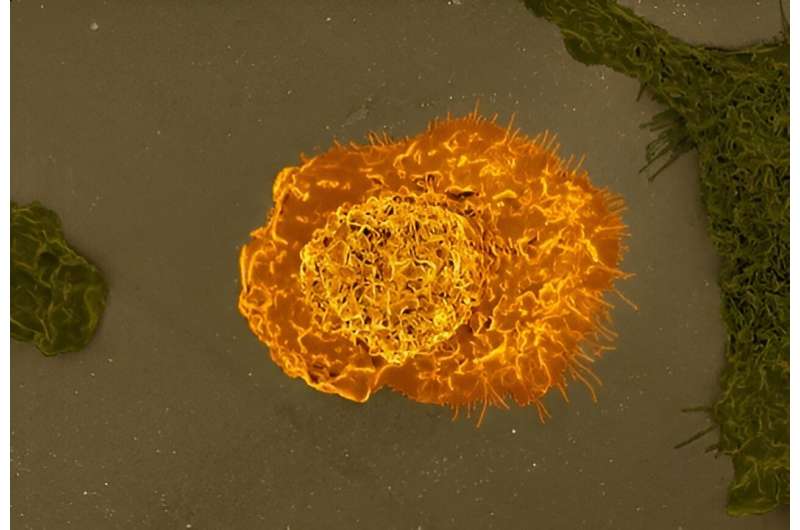This article has been reviewed according to Science X's editorial process and policies. Editors have highlighted the following attributes while ensuring the content's credibility:
fact-checked
peer-reviewed publication
trusted source
proofread
New study sheds light on the molecular mechanisms underlying SLC29A3 disorders

In humans, the SLC29A3 gene regulates the function of lysosomes to control waste recycling in cells such as macrophages (that engulf and destroy foreign bodies). This gene encodes for the lysosomal protein that transport nucleosides—degradation products of RNA and DNA—from lysosomes to the cytoplasm. Loss-of-function mutations in the SLC29A3 gene lead to aberrant nucleoside storage, resulting in a spectrum of conditions called SLC29A3 disorders.
These disorders can manifest in the form of pigmented skin patches, enlargement of the liver/spleen, hearing loss, or type 1 diabetes. A key manifestation of this group of disorders is histiocytosis, which is characterized by the accumulation of mononuclear phagocytes (histiocytes) in multiple organs. However, the molecular link between lysosomal nucleoside storage and histiocytosis has remained elusive so far, making the treatment of this condition challenging.
A team of Japanese researchers has now been able to solve this mystery and establish the mechanism underlying SLC29A3 disorders. Their study was published in the Journal of Experimental Medicine. The findings clearly describe how the aberrant responses of toll-like receptor (TLR) 7 and TLR8—immune proteins expressed on macrophages—drives histiocytosis under conditions of SLC29A3 loss-of-function.
"We have now uncovered how TLR signaling, a key innate immune response pathway, contributes to histiocytosis in SLC29A3 disorders," remarks Prof. Kensuke Miyake from The Institute of Medical Science, The University of Tokyo, also the corresponding author of the article.
Pathogens engulfed by macrophages are broken down within the lysosomes. The degradation of pathogenic RNA leads to the generation of nucleosides, which can be sensed by TLR7 and TLR8. Given that SLC29A3 mutations lead to abnormal nucleoside storage within lysosomes, the authors hypothesized that the constitutive activation of TLR7 and TLR8 by nucleosides would be involved in SLC29A3 disorders. They tested this hypothesis in mice lacking this gene.
While Slc29a3–/– mice showed significant nucleoside accumulation and histiocytosis, the latter phenotype disappeared when the TLR7 gene was knocked out (i.e., in Slc29a3–/– Tlr7–/– mice). This demonstrated that the histiocytosis occurring due to SLC29A3 mutations was dependent on TLR7.
The results also showed that in Slc29a3–/– mice, during excess lysosomal nucleoside storage, TLR7 promoted the proliferation and maturation of a subset of macrophages. Similar findings were observed in patient-derived monocytes with a SLC29A3 mutation.
These monocytes showed greater survival and proliferation after stimulation with macrophage colony stimulating factor (M-CSF), a macrophage survival factor, than monocytes derived from healthy subjects . Interestingly, this enhanced survival and proliferation was attenuated when TLR8 was inhibited; human monocytes use TLR8 rather than TLR7 to respond to nucleosides.
Associate Prof. Takuma Shibata, who is also the lead author on this study, explains, "To put it simply, mutations in SLC29A3 lead to nucleoside accumulation in macrophages. These nucleosides activate TLR7 and TLR8, and this excessive TLR response leads to excess macrophage proliferation and accumulation." Prof. Miyake adds, "In a way, our findings show that SLC29A3 acts as a negative regulator of the TLR7/8 response in cells of the innate immune system."
The study by the group led by Prof. Miyake and Associate Prof. Shibata answers a long-standing question in the field of innate immunology. "TLR7 and TLR8 could serve as therapeutic targets for SLC29A3 disorders, and this is very promising from the perspective of developing novel therapeutic interventions for these conditions. Moreover, the findings can also pave the way for understanding the pathogenic mechanisms of other disorders associated with macrophage proliferation and accumulation," Prof. Miyake concludes.
More information: Takuma Shibata et al, TLR7/8 stress response drives histiocytosis in SLC29A3 disorders, Journal of Experimental Medicine (2023). DOI: 10.1084/jem.20230054



















